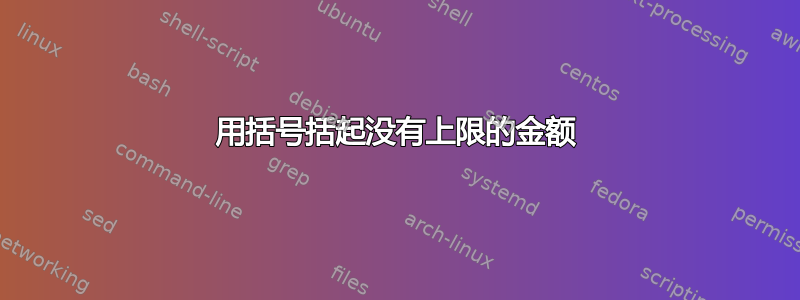
梅威瑟:
\documentclass[12pt]{article}
\usepackage{amsmath}
\begin{document}
\thispagestyle{empty}
\[ \mathcal{F} \left\{ \sum_j e^{-2i\pi\nu_j t} \right\} \]
\end{document}
结果:

总和仅在底部有限制,但括号大小的计算方式好像它有两个限制,导致顶部有大量不需要的空间。有没有办法让括号只包裹底部限制?
答案1
这是预期的行为,因为括号相对于公式轴(位于求和符号的垂直中心)对称放置。
如果太小,则使用\Bigl\{和或和代替和:\Bigr\}\biggl\{\biggr\}\left\{\right\}
\documentclass{article}
\begin{document}
\[
\mathcal{F}\Bigl\{\sum_{j}e^{-2i\pi\nu_j t}\Bigr\}
\]
\[
\mathcal{F}\biggl\{\sum_{j}e^{-2i\pi\nu_j t}\biggr\}
\]
\end{document}

答案2
您可以通过以下方式垂直居中总和:
\documentclass[12pt]{article}
\usepackage{amsmath}
\newcommand*{\mvcenter}[1]{\vcenter{\hbox{$\displaystyle #1$}}}
\begin{document}
\thispagestyle{empty}
\[
\mathcal{F} \left\{ \mvcenter{\sum_j e^{-2i\pi\nu_j t}} \right\}
\]
\end{document}

我会小心使用它:你现在有对称性,但是内部公式基线是不同的。
答案3
另外两种解决方案,在我看来,从技术角度来看既不好也不坏,就是\smash和的组合\vphantom,或者\textsyle排版 :
\[
\mathcal{F} \left\{ \vphantom{\sum}\smash{\sum_{j}} e^{-2i\pi\nu_j t} \right\}
\quad\text{or}\quad
\mathcal{F}\Big\{ \textstyle\sum_{j} e^{-2i\pi\nu_j t}\Big\}
\]
其中 的基线\mathcal{F}与 的基线保持一致\Sigma。

编辑:如果您对此不满意,可以j使用 来添加线条\sum\nolimits_{j}。
为了进一步微调分隔符高度和方程高度,您可以加载calc包并定义宏:
\newlength{\hhh}
\newcommand{\mstrut}[2][2]{%
\settototalheight{\hhh}{$\displaystyle #2$}%
\rule[-0.5\hhh*\real{#1}+0.5ex]{0pt}{#1\hhh}%
}
绘制一条不可见的规则,其高度是强制参数的高度乘以可选参数的高度(默认设置为 1)。使用此宏,代码
\[ \boxed{
\mathcal{F} \left\{\mstrut[0.7]{\sum_{j}} \smash{\sum_{j}} e^{-2i\pi\nu_j t} \right\}
\quad\text{or}\quad
\mathcal{F} \left\{\mstrut[0.9]{\sum_{j}} \smash{\sum_{j}} e^{-2i\pi\nu_j t} \right\}
\mstrut[2]{\sum_{j}}
} \]
我们得到:编辑:在上面的代码中
 抑制了,因为它是由 超级播种的。
抑制了,因为它是由 超级播种的。\vphantum\mstrut
其中\mstrut厚度设置1pt为用于演示目的,并且盒子实现方程的上限和下限。
通过这种方式,选择适当的值 int\mstrut[?]{}您可以控制分隔符的大小和垂直间距......
答案4
您也可以使用\raise或\lower命令来移动括号:
\[ \mathcal{F} {\lower4.5pt\hbox{$\bigg\{$}} \sum_j e^{-2i\pi\nu_j t} {\lower4.5pt\hbox{$\bigg\}$}} \]
因此,括号中包含了它们的参数,而上方没有太多空间,但现在您没有一个对称公式:如果在后添加集合运算符\mathcal{F},它将与此字形对齐,而不是与括号的中心对齐。


